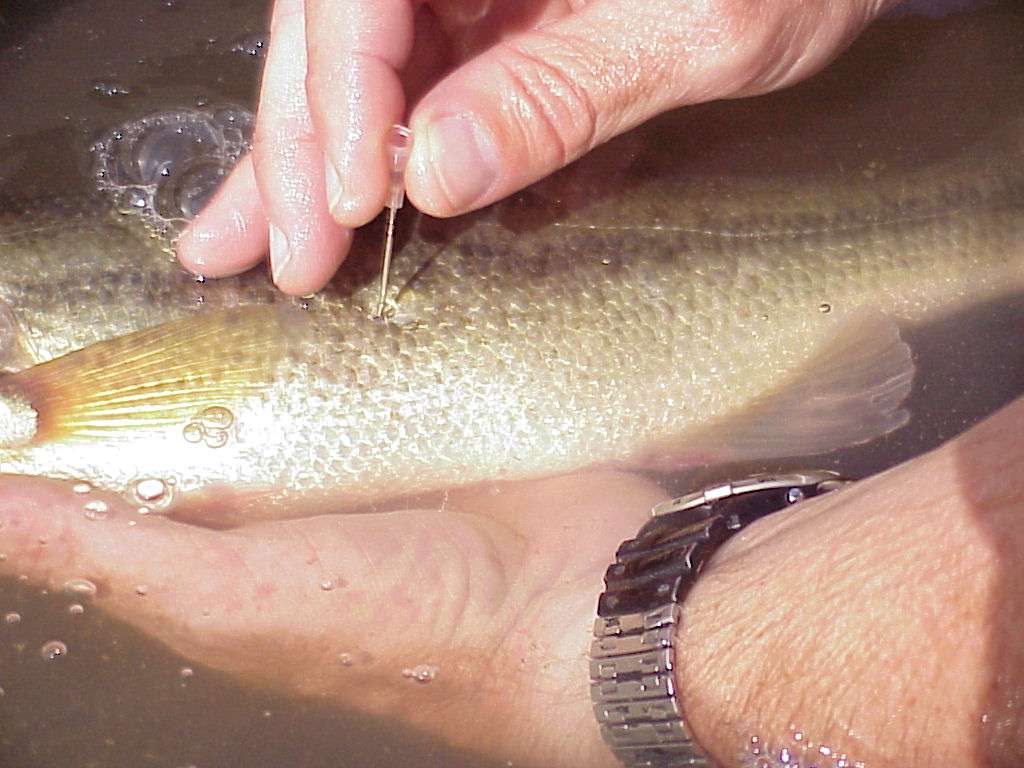
During the recent Bassmaster Elite Series Northern Swing, there was a lot of talk during the Bassmaster LIVE coverage regarding “fizzing” – the technique of venting the excess gas from a bass’ overinflated swim bladder that had been caught in deep water.
Bringing bass to the surface from deeper water results in a rapid expansion of the bladder because of reduced water pressure – a condition called “barotrauma.” This condition is more commonly an issue when fish are caught at depths greater than 20-30 feet, but symptoms can exhibit themselves as a stress reaction in fish caught from much shallower water.
Fish adjust the pressure in their swim bladders to remain neutrally buoyant which saves energy, but unfortunately, bass can’t burp. That gas is slowly diffused into or out of the bladder through a network of blood vessels. So when their swim bladder is overinflated, unless these fish can return to depth quickly on their own or with the aid of a descending device, they will struggle at the surface where their chances of survival are drastically reduced.
The symptoms of barotrauma include an inability to maintain equilibrium; the fish constantly struggles to stay submerged, often floating with tails, heads or sides breaking the surface. A lump may appear on their side. The real problem here is that an overinflated bladder puts abnormal pressure on vital organs, can hamper breathing, restrict blood flow and can cause permanent and unseen internal damage.
Fish suffering from barotrauma need to be treated at the first sign of distress. It cannot wait for the tournament staff to administer first aid after the weigh-in. By then the damage may have been done and survival compromised.
Weighted clips attached to the pelvic or anal fins do not cure the problem. They help the fish stay upright in the livewell and reduce struggling which saves energy, but the damage to internal organs and the potential for reduced blood flow are still there. Simply because a fish swims away after weigh-in does not mean it will survive.
Although some state fishery agencies still discourage fizzing based on fears that the technique is too difficult to learn or jeopardizes the health of the fish, research in Ontario, California and Texas has shown the value of the technique in reducing physiological stress and mortality among both largemouth and smallmouth bass.
Treatment for barotrauma involves using a 1 1/2-inch-long, 18-gauge hypodermic needle to vent the excess gas. Original how-to instructions were confusing, and many anglers avoided fizzing for fear of injuring fish. In the mid-90s, a technique that involved inserting the needle through the mouth was popularized. Many anglers found this technique easier and assumed it caused less damage.
However, in trials conducted by Texas Parks & Wildlife Department under controlled conditions, researchers found that survival was significantly higher among fish that were side fizzed compared to those fizzed through the mouth. Autopsies revealed that inserting the needle through the mouth was more likely to cause hidden damage to blood vessels and vital organs. Fish could bleed internally. Side fizzing provides a larger target area with less chance of injury.

The location for side fizzing needle insertion was described in the late 1980s by drawing a line on the side of the fish between the dorsal and anal fins and counting rows of scales down from the lateral line. This was often slow and confusing, so this more recent diagram was developed and is easier to follow:


Fizzing is a valuable tool that tournament officials and contestants need to become proficient with, especially when fishing at times of the year when bass are likely to be caught from deep water. Anglers should learn to relieve the air bladder pressure in the boat rather than waiting for tournament officials to provide treatment.
Another advancement in the fizzing protocol in the needle-cleaning “reamer” developed by New York B.A.S.S. Nation Conservation Director, Barb Elliott. A thin wire is inserted into the needle to help prevent clogging during insertion. It makes the process almost foolproof. Message Elliott via Facebook to purchase a Fizz Kit which include needles with reamers and fully illustrated instructions.

These videos go into more detail explaining the problem with barotrauma and the proper fizzing technique for both:
Recently there has been concern voiced about the possibilities of spreading infection between fish fizzed with the same needle. The Texas study and another in Ontario found good survival among fizzed fish, with rapid healing. If there is a concern, keeping a number of fizzing needles in a vial of alcohol and allowing them to air-dry before each use is all that is necessary.
To fizz or not to fizz? The answer is yes, if the symptoms dictate. Once you learn when and how to fizz you may be saving bass that might otherwise struggle to survive, and in doing so you will help preserve valuable fisheries resources.





